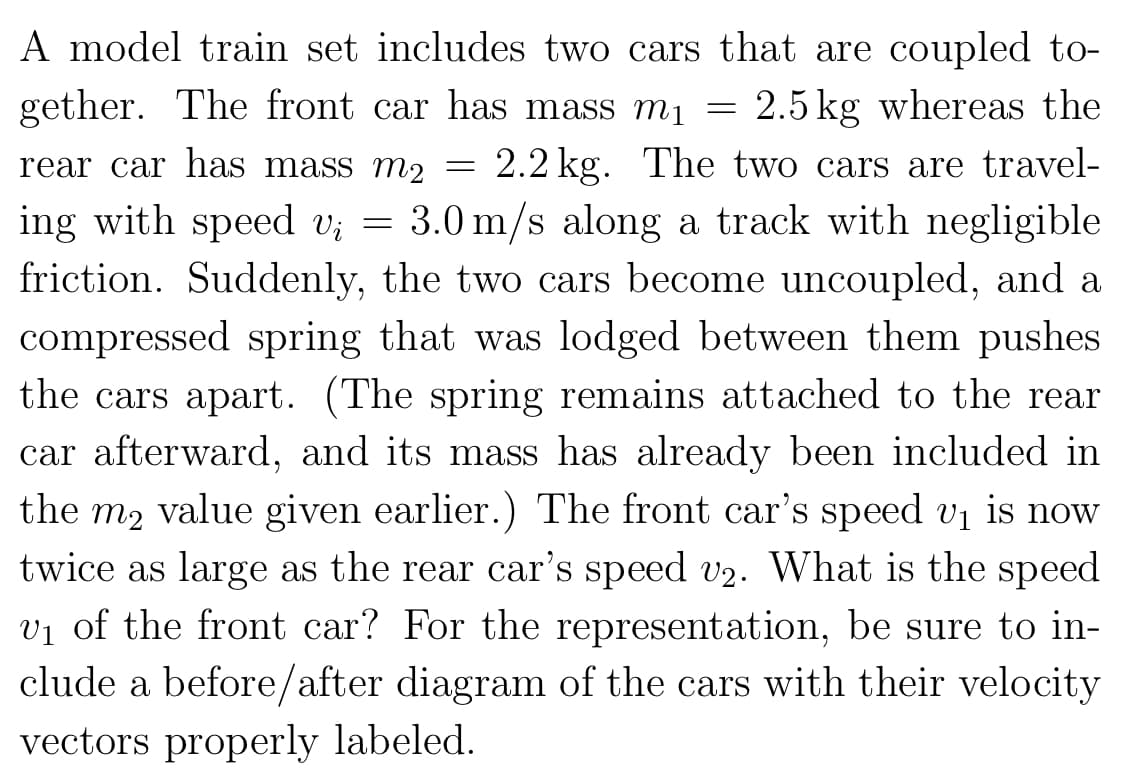A model train set includes two cars that are coupled to- gether. The front car has mass m₁ = 2.5 kg whereas the rear car has mass m₂ 2.2 kg. The two cars are travel- ing with speed v₁ = 3.0 m/s along a track with negligible friction. Suddenly, the two cars become uncoupled, and a compressed spring that was lodged between them pushes the cars apart. (The spring remains attached to the rear car afterward, and its mass has already been included in the m₂ value given earlier.) The front car's speed v₁ is now twice as large as the rear car's speed v2. What is the speed v₁ of the front car? For the representation, be sure to in- clude a before/after diagram of the cars with their velocity vectors properly labeled. =
A model train set includes two cars that are coupled to- gether. The front car has mass m₁ = 2.5 kg whereas the rear car has mass m₂ 2.2 kg. The two cars are travel- ing with speed v₁ = 3.0 m/s along a track with negligible friction. Suddenly, the two cars become uncoupled, and a compressed spring that was lodged between them pushes the cars apart. (The spring remains attached to the rear car afterward, and its mass has already been included in the m₂ value given earlier.) The front car's speed v₁ is now twice as large as the rear car's speed v2. What is the speed v₁ of the front car? For the representation, be sure to in- clude a before/after diagram of the cars with their velocity vectors properly labeled. =
Elements Of Electromagnetics
7th Edition
ISBN:9780190698614
Author:Sadiku, Matthew N. O.
Publisher:Sadiku, Matthew N. O.
ChapterMA: Math Assessment
Section: Chapter Questions
Problem 1.1MA
Related questions
Question
can you pls also draw a picture/representation of the scenario described? Thanks so much!

Transcribed Image Text:A model train set includes two cars that are coupled to-
gether. The front car has mass m₁ = 2.5kg whereas the
rear car has mass m₂ 2.2 kg. The two cars are travel-
ing with speed v₁ = 3.0 m/s along a track with negligible
friction. Suddenly, the two cars become uncoupled, and a
compressed spring that was lodged between them pushes
the cars apart. (The spring remains attached to the rear
car afterward, and its mass has already been included in
the m₂ value given earlier.) The front car's speed v₁ is now
twice as large as the rear car's speed v2. What is the speed
v₁ of the front car? For the representation, be sure to in-
clude a before/after diagram of the cars with their velocity
vectors properly labeled.
=
Expert Solution
This question has been solved!
Explore an expertly crafted, step-by-step solution for a thorough understanding of key concepts.
This is a popular solution!
Trending now
This is a popular solution!
Step by step
Solved in 2 steps with 1 images

Knowledge Booster
Learn more about
Need a deep-dive on the concept behind this application? Look no further. Learn more about this topic, mechanical-engineering and related others by exploring similar questions and additional content below.Recommended textbooks for you

Elements Of Electromagnetics
Mechanical Engineering
ISBN:
9780190698614
Author:
Sadiku, Matthew N. O.
Publisher:
Oxford University Press

Mechanics of Materials (10th Edition)
Mechanical Engineering
ISBN:
9780134319650
Author:
Russell C. Hibbeler
Publisher:
PEARSON

Thermodynamics: An Engineering Approach
Mechanical Engineering
ISBN:
9781259822674
Author:
Yunus A. Cengel Dr., Michael A. Boles
Publisher:
McGraw-Hill Education

Elements Of Electromagnetics
Mechanical Engineering
ISBN:
9780190698614
Author:
Sadiku, Matthew N. O.
Publisher:
Oxford University Press

Mechanics of Materials (10th Edition)
Mechanical Engineering
ISBN:
9780134319650
Author:
Russell C. Hibbeler
Publisher:
PEARSON

Thermodynamics: An Engineering Approach
Mechanical Engineering
ISBN:
9781259822674
Author:
Yunus A. Cengel Dr., Michael A. Boles
Publisher:
McGraw-Hill Education

Control Systems Engineering
Mechanical Engineering
ISBN:
9781118170519
Author:
Norman S. Nise
Publisher:
WILEY

Mechanics of Materials (MindTap Course List)
Mechanical Engineering
ISBN:
9781337093347
Author:
Barry J. Goodno, James M. Gere
Publisher:
Cengage Learning

Engineering Mechanics: Statics
Mechanical Engineering
ISBN:
9781118807330
Author:
James L. Meriam, L. G. Kraige, J. N. Bolton
Publisher:
WILEY